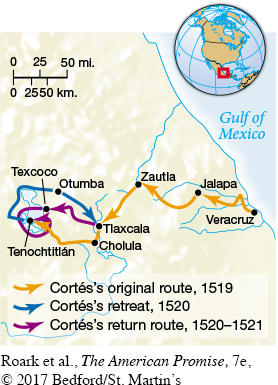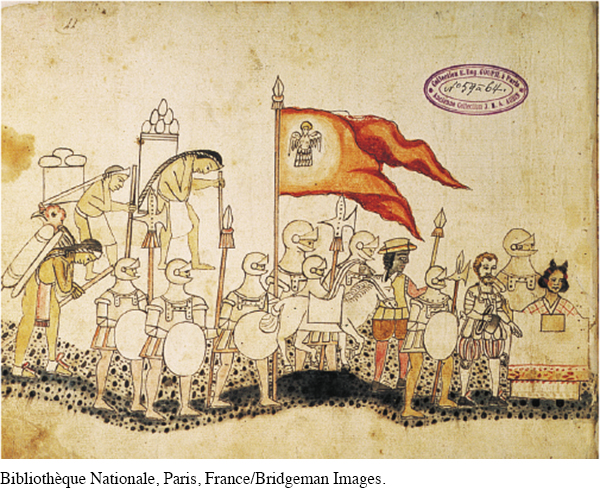The American Promise: Printed Page 35
The American Promise, Value Edition: Printed Page 34
The American Promise: A Concise History: Printed Page 39
The Conquest of Mexico
Hernán Cortés, an obscure nineteen-

A charismatic and confident man, Cortés could not speak any Native American languages. Landing first on the Yucatán peninsula with his ragtag army, he had the good fortune to receive from a local Tobascan chief the gift of a young girl named Malinali. She spoke several native languages, including Nahuatl, the language of the Mexica, the most powerful people in what is now Mexico and Central America (see “The Mexica: A Mesoamerican Culture” in chapter 1). Malinali, whom Spaniards called Marina, had acquired her linguistic skills painfully. Born into a family of Mexican nobility, she learned Nahuatl as a child. After her father died and her mother remarried, her stepfather sold her as a slave to Mayan-
In Tenochtitlán, the capital of the Mexican empire, the emperor Montezuma heard about some strange creatures sighted along the coast. (Montezuma and his people called themselves Mexica.) The emperor sent representatives to bring the strangers large quantities of food. Before the Mexican messengers served food to the Spaniards, they sacrificed several hostages and soaked the food in their blood. This fare disgusted the Spaniards and might have been enough to turn them back to Cuba. But along with the food, the Mexica also brought the Spaniards another gift, a “disk in the shape of a sun, as big as a cartwheel and made of very fine gold,” as a Mexican recalled. Here was conclusive evidence that the rumors of fabulous riches heard by Cortés had some basis in fact.
In August 1519, Cortés marched inland to find Montezuma. Leading about 350 men, Cortés had to live off the land, establishing peaceful relations with indigenous tribes when he could and killing them when he thought it necessary. On November 8, 1519, Cortés reached Tenochtitlán, where Montezuma welcomed him and showered the Spaniards with lavish hospitality. Quickly, Cortés took Montezuma hostage and held him under house arrest, hoping to make him a puppet through whom the Spaniards could rule the Mexican empire. This uneasy peace existed for several months until one of Cortés’s men led a brutal massacre of many Mexican nobles, causing the people of Tenochtitlán to revolt. Montezuma was killed, and the Mexica mounted a ferocious assault on the Spaniards. On June 30, 1520, Cortés and about a hundred other Spaniards fought their way out of Tenochtitlán (losing much of the gold they had confiscated since it proved too heavy to carry away in haste) and retreated about one hundred miles to Tlaxcala, a stronghold of bitter enemies of the Mexica. Tlaxcalans—
In the spring of 1521, Cortés and thousands of Indian allies laid siege to the Mexican capital. With a relentless, scorched-
